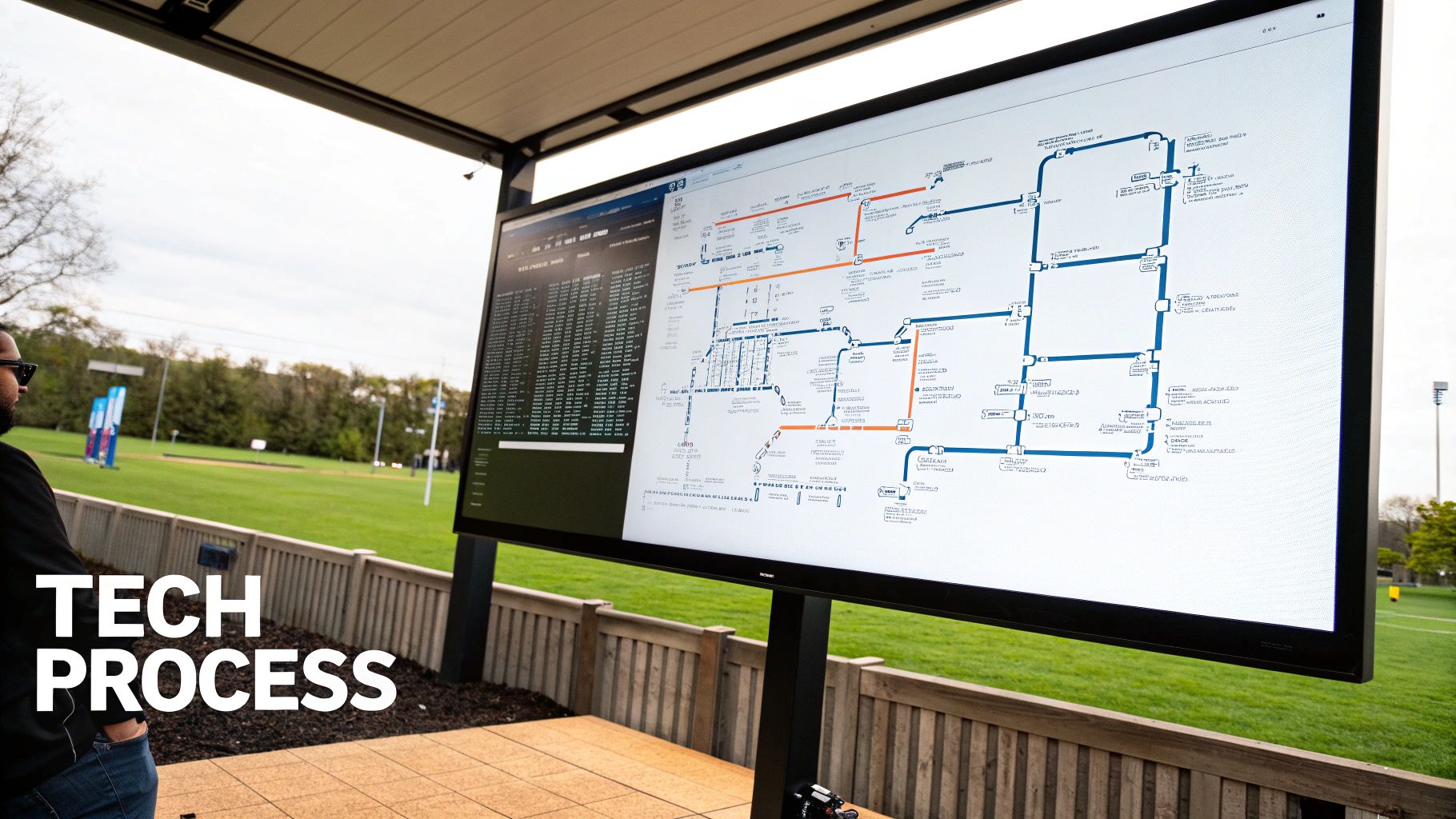Transparent video compression: Efficiency meets quality
The Science Behind Truly Transparent Compression

Transparent video compression seems contradictory: shrinking file size while keeping the original visual quality. This balancing act relies on understanding how our eyes work. We're more sensitive to brightness changes than color shifts, letting algorithms simplify color data without us noticing.
This saves valuable data space. Our eyes also miss fine details in fast-moving or complex scenes. Transparent compression uses this by using fewer bits for these areas and focusing on detail in simpler parts of the frame. This bit allocation strategy is central to modern codecs.
Perceptual Coding: Tricking the Eye
Modern compression uses perceptual coding: analyzing video to find areas where information can be removed or simplified without impacting perceived quality. It's like a magician's sleight of hand – the trick works because your focus is elsewhere. The codec discards information your eye likely won't see.
Transparent video compression also uses algorithms to predict movement between frames. By predicting how objects move, the codec stores differences between frames instead of whole frames. This inter-frame prediction cuts redundancy and shrinks file size. Transparency in compression means the compressed video looks the same as the original. This is vital for live broadcasts or cinema where quality matters most.
The JPEG XS standard aims for visually lossless compression with low latency, ideal for high-resolution video. It supports 2:1 to 6:1 compression, reducing bandwidth needs while maintaining quality. JPEG XS development uses extensive testing, including subjective evaluations to ensure quality.
The Role of Psychovisual Redundancy
Psychovisual redundancy is another key aspect. This refers to information present in the video but not visually important. Our eyes have limited sensitivity to very high spatial frequencies (fine detail). Compression algorithms use this by reducing these details, knowing they’ll be unnoticed.
Eliminating redundant information helps achieve high compression without sacrificing quality. This balance between compression and visual quality makes transparent video compression a challenging, ever-evolving area.
From Blocky Artifacts to Crystal Clear: The Evolution Story
Remember those early internet videos? Grainy, pixelated, and a real challenge to watch if they were longer than a few minutes. That was the reality before smooth, clear video compression became the norm. The journey to seamless streaming has been a fascinating one, full of breakthroughs and teamwork.
The way we compress video has changed dramatically over time. A major leap forward came in the early 1970s with the Discrete Cosine Transform (DCT). Developed by Nasir Ahmed and his colleagues, the DCT revolutionized image compression. This technique became the foundation for most modern video compression standards, including H.120 in 1984 and H.261 in 1988. Learn more about the history of video compression. These early achievements laid the groundwork for the high-quality video we enjoy now.
The Quest for Transparency
Early video compression often produced visible artifacts—those blocky distortions that plagued low-bandwidth videos. Limited processing power and simple algorithms were the main culprits. As technology improved, the focus shifted to "transparent" compression. The goal? Make compressed video indistinguishable from the original. This meant creating smarter algorithms that could analyze video content and remove data the human eye wouldn't miss.
Enabling the HD Era
High-definition video presented new obstacles. Higher resolutions meant a huge increase in data, pushing existing compression technologies to their limits. This demand fueled innovation, leading to more efficient codecs like H.264 (AVC) and later HEVC (H.265). These standards delivered much better compression while maintaining good visual quality, making HD video streaming a reality. The improvements in transparent video compression are what made today’s streaming revolution possible.
The Role of International Standards
Transparent video compression wouldn’t be what it is today without global collaboration. Groups like the International Telecommunication Union (ITU) and the Moving Picture Experts Group (MPEG) were vital in developing and standardizing compression technologies. These standards ensured that videos could play on various devices and platforms, creating a unified video delivery system.
Continuous Improvement: Beyond HEVC
The progress doesn't stop with HEVC. New codecs like AV1 and VVC are pushing the boundaries of transparent video compression even further. They aim for even greater compression efficiency, preparing for 4K, 8K, and higher resolutions. The constant drive for better compression comes from the growing need for high-quality video in everything from video conferencing to virtual reality.
Cutting-Edge Codecs That Deliver Transparency

Today's video compression technology achieves amazing results, shrinking files dramatically while keeping the quality nearly identical to the original. This magic happens thanks to codecs, algorithms that encode and decode video data. These codecs represent decades of ongoing research, constantly improving to meet the ever-increasing demand for high-quality video.
The Power of Modern Codecs: HEVC, AV1, and VVC
Several codecs are at the forefront of this transparent video revolution. High Efficiency Video Coding (HEVC), also known as H.265, is a leading example. HEVC cuts the bitrate by 50% compared to its predecessor, H.264/AVC, while maintaining the same visual quality. This efficiency is critical for streaming and broadcasting high-resolution video. HEVC supports resolutions up to 4320p and uses improved parallel processing, making it suitable for demanding applications. Its development involved extensive testing to ensure its superior performance. Learn more about HEVC.
Another important codec is AV1, an open-source, royalty-free codec created by the Alliance for Open Media. AV1 aims to offer even better compression than HEVC, making it an attractive option for web video. And then we have Versatile Video Coding (VVC), or H.266, the successor to HEVC. VVC pushes the limits even further, targeting another major bitrate reduction without sacrificing visual quality.
To help you understand the differences, let's look at a comparison table:
To help illustrate the key differences between these codecs, the following table provides a detailed comparison:
Comparison of Modern Compression Standards This table compares key parameters of leading video compression standards focused on transparency.
| Standard | Compression Ratio | Quality Level | Latency | Resolution Support | Key Applications |
|---|---|---|---|---|---|
| HEVC (H.265) | Up to 50% better than H.264 | High | Moderate | Up to 8K (8192×4320) | Streaming, broadcasting, Blu-ray |
| AV1 | Up to 30% better than HEVC | High | Moderate to High | Up to 8K (8192×4320) | Web video, streaming |
| VVC (H.266) | Up to 50% better than HEVC | High | High | Up to 16K (15360×8640) | Next-generation video applications, high-resolution content |
These codecs represent the continuous drive for innovation in video compression technology.
How These Codecs Achieve Transparency
These codecs use complex analysis to find areas where data can be removed or simplified without impacting visual quality. They take advantage of the fact that our eyes are less sensitive to certain details, such as high-frequency information in busy scenes. This allows the codecs to use fewer bits in these areas and focus on preserving the important details.
These codecs also use advanced inter-frame prediction. By analyzing motion between frames, they can predict the content of future frames and store only the changes, reducing redundancy and file size. This technique is key to high compression without quality loss.
Implementation Considerations and Challenges
Using transparent video compression requires careful planning. Hardware requirements can be significant, especially for real-time encoding of high-resolution video. Compatibility is also crucial. Ensuring playback across different devices and platforms is essential. However, the benefits of smaller files, better streaming, and faster downloads make these challenges worthwhile. The ongoing progress in video compression continues to change how we create, share, and enjoy video.
Beyond Guesswork: Measuring True Transparency
How do we really know when video compression is truly transparent? It's not a matter of opinion – it's based on solid scientific methods. Evaluating how well transparent video compression works depends on both objective measurements and what people actually see. Let's take a look at these methods.
Objective Metrics: Quantifying the Invisible
Objective metrics use mathematical formulas to compare the compressed video with the original. This gives us hard data about the differences. Here are some commonly used metrics:
- VMAF (Video Multimethod Assessment Fusion): Developed by Netflix, VMAF combines several quality metrics and machine learning to predict how viewers perceive video quality. It's considered one of the best objective metrics available.
- SSIM (Structural Similarity Index): SSIM measures how similar two images are based on brightness, contrast, and structure. It's a widely used metric for checking how much image quality has degraded.
- PSNR (Peak Signal-to-Noise Ratio): PSNR calculates the ratio between the maximum possible signal power and the power of the noise that's messing it up. While it's easy to calculate, PSNR doesn't always match up with what people actually see.
These metrics give us a basic understanding of how compression affects video quality. But there's more to the story.
The Human Factor: Perceptual Testing
Objective metrics are helpful, but what humans perceive is the ultimate test of transparent video compression. Perceptual testing involves showing people compressed and original videos in a controlled setting. They're then asked to rate the quality or point out any differences.
These tests can be done in a few ways:
- Double-Blind Comparisons: People are shown two versions of the same video – one compressed, one original – without knowing which is which. This helps avoid bias.
- ABX Testing: People see sample A, sample B (one compressed, one original), and sample X (a copy of either A or B). They then have to say whether X matches A or B.
These tests show how compression artifacts, like blockiness or blur, affect the viewing experience.
Real-World Scenarios and Viewing Conditions
Testing transparency also means considering how people actually watch videos. Things like screen size, viewing distance, and room lighting all change how we perceive quality. Compression artifacts might be more obvious on a big screen compared to a phone.
Major studios and streaming services do rigorous testing under all sorts of conditions to make sure their content looks great for everyone. They also consider different types of content, because the ideal compression for an action movie might not work for a drama.
Building Your Own Quality Validation Process
Setting up a quality check process doesn't have to be expensive. You can start with free tools and metrics to analyze your compressed videos. Even doing small tests with coworkers or friends can give you valuable feedback.
By understanding how both objective metrics and human perception play a role in checking transparency, you can make smart choices about your video compression strategy. This helps you provide the best possible viewing experience. It's all about finding that sweet spot: the smallest file size with the best visual quality.
Transparent Compression In Action: Industry Success Stories

Transparent video compression is changing how industries manage and deliver video. This section explores real-world uses where this technology excels, showing how it improves workflows and cuts costs without sacrificing quality. These examples highlight the tangible benefits and achievable results of transparent video compression.
Broadcasting: Maintaining Quality While Optimizing Bandwidth
Broadcasters constantly strive to deliver high-quality video to vast audiences while managing limited bandwidth. Transparent video compression provides a solution by shrinking file sizes without noticeable quality loss. This means networks can broadcast higher resolution video with less bandwidth, resulting in substantial cost savings.
For example, a sports broadcaster could use transparent video compression with the HEVC standard to deliver 4K content at a similar bitrate to HD broadcasts using older codecs. This lets viewers enjoy sharper visuals without increased bandwidth demands.
Medical Imaging: Preserving Diagnostic Detail For Remote Collaboration
In medical imaging, every detail matters for accurate diagnoses. Transparent video compression lets professionals share large imaging files (like MRI scans or ultrasound videos) quickly and efficiently, without losing crucial diagnostic information. This is vital for remote consultations, enabling specialists to access and review key visual data from anywhere.
Furthermore, archiving large datasets becomes easier, improving storage efficiency and accessibility. This enhanced access contributes to better patient care.
Film Production: Protecting Creative Vision Throughout Post-Production
Film studios work with huge video files throughout post-production. Transparent video compression provides efficient management of these files without compromising the director's vision. Editors can work with high-resolution footage more smoothly, leading to faster rendering times. Archiving original footage also becomes less demanding, preserving valuable assets while minimizing storage costs. This helps studios maintain the highest quality throughout production.
To better illustrate the benefits and applications of transparent video compression across various industries, let's take a look at the following table:
Table: Transparent Compression Use Cases & Benefits
This table presents industry-specific applications of transparent video compression and their quantifiable outcomes.
| Industry | Application | Compression Standard Used | Bandwidth/Storage Reduction | Quality Impact | Business Benefit |
|---|---|---|---|---|---|
| Broadcasting | Live 4K Sports | HEVC | Up to 50% | Visually Lossless | Reduced transmission costs, higher quality broadcasts |
| Medical Imaging | Remote Diagnostics | JPEG XS | 2:1 to 6:1 | Perceptually Lossless | Faster collaboration, improved diagnostic accuracy, efficient archiving |
| Film Production | Post-Production Workflow | VVC | Up to 50% better than HEVC | Visually Lossless | Streamlined editing, faster rendering, optimized archiving |
As shown in the table above, transparent video compression provides significant advantages across a range of applications. The substantial reduction in bandwidth and storage needs, coupled with the minimal impact on visual quality, translates to tangible business benefits such as cost savings and improved workflows.
These examples showcase the practical advantages of transparent video compression across diverse fields. You might be interested in: How to master file compression for reducing digital waste. Balancing efficiency and quality makes it a valuable tool. By reducing file sizes without noticeable quality loss, transparent video compression streamlines workflows, optimizes storage, and improves collaboration, driving innovation in video processing and delivery. Businesses can save money while ensuring high-quality viewing experiences. Transparent video compression continues to develop, offering more efficient solutions for managing the increasing demands of video content.
The Future of Transparent Video Compression
Transparent video compression is a constantly evolving field. The drive to improve comes from two main sources: the desire for higher quality video and the need to store and transmit that video efficiently. So, what's next for this technology?
AI-Powered Encoding: The Next Leap Forward
One exciting area of development is AI-powered encoding. These algorithms leverage machine learning to analyze video content, predicting which parts viewers will find most important. By prioritizing these areas and allocating more bits to them, AI encoders can achieve better compression without sacrificing noticeable quality. Imagine a codec that understands what catches your eye and prioritizes that information – that’s the potential of AI.
For example, in a video with a fast-paced action scene against a static background, the AI could focus on the detailed movements of the characters while optimizing the background. This leads to smaller file sizes without impacting the overall visual experience.
Content-Aware Compression: Beyond One-Size-Fits-All
Current compression standards typically apply the same techniques regardless of the video content. Content-aware compression, however, adapts the compression algorithm to the specifics of the video. A codec could, for example, identify text or sharp lines and use specialized techniques to maintain those details, while using different methods for smoother areas or fast motion.
This tailored approach results in more efficient compression and enhanced visual fidelity. It’s about making compression intelligent and responsive to the content itself.
Emerging Challenges: Volumetric Video and Beyond
New video formats like volumetric video, which create 3D representations of scenes, present unique compression challenges. These files are significantly larger than traditional 2D video, demanding new compression strategies for effective management. The sheer volume of data in volumetric video is driving the development of innovative codecs and algorithms.
Changing Viewing Habits: Optimizing for Mobile
With the rise of mobile video consumption, optimizing for these viewing experiences is increasingly important. Codecs need to run efficiently on mobile processors and account for smaller screen sizes. Future codecs will likely incorporate these factors to deliver the best possible mobile viewing experience.
The Future of Transparency: Constant Innovation
The pursuit of better transparent video compression is an ongoing journey. Research and development efforts are exploring new ways to exploit psychovisual redundancy, essentially finding more information our eyes don't register. These advancements hold the greatest potential for shrinking file sizes without affecting perceived visual quality. Transparent video compression is constantly evolving, always striving for better efficiency and a seamless viewing experience.
Implementing Transparent Compression: Your Practical Guide

Putting transparent video compression into practice takes a structured approach. This guide offers practical steps for optimal results in your video projects, from picking the right codec to integrating compression into your workflow. Following these steps can significantly reduce file sizes without losing visual quality.
Choosing the Right Codec
Codec selection is the foundation of transparent compression. Different codecs offer varying levels of compression and quality. Consider these factors:
- Target Quality: How crucial is perfect visual fidelity? For archives or professional work, codecs like VVC might be best. For web content, HEVC or AV1 could work.
- Hardware Compatibility: Encoding and decoding some codecs (like VVC) demand more processing power. Think about your target devices.
- File Size Requirements: What compression level is needed? Codecs like VVC compress more than HEVC, leading to smaller files.
- Royalty Considerations: Some codecs have licensing fees. Open-source options like AV1 avoid these.
Encoder Configuration: Fine-Tuning for Transparency
After choosing a codec, encoder configuration is key for maximizing transparency. Experiment with these settings:
- CRF (Constant Rate Factor): This balances quality and file size. Lower CRF means higher quality, larger files.
- Preset: Presets offer pre-configured settings for various quality levels. Test to find what works for you.
- Bitrate Control: For steady quality, use Constant Bitrate (CBR) encoding. For maximum compression, consider Variable Bitrate (VBR).
- Two-Pass Encoding: This analyzes the video first, then optimizes encoding in the second pass, often improving quality at a given bitrate.
Validating Your Results
Testing ensures your compressed video meets your standards.
- Objective Metrics: Use tools measuring VMAF, SSIM, or PSNR to assess quality differences.
- Subjective Viewing: Compare compressed and original videos side-by-side to spot any visible issues.
Check out our guide on optimizing videos for social media for more compression tips.
Integrating with Existing Workflows
Successful implementation means incorporating compression smoothly.
- Batch Processing: Automate compression of many files using scripts or tools.
- Cloud Integration: Use cloud-based encoding services to offload processing.
- Pipeline Optimization: Integrate compression into your video editing or delivery pipeline.
Troubleshooting Common Challenges
- Hardware Limitations: If encoding is slow, consider hardware acceleration or distributed processing.
- Compatibility Issues: Ensure your codec and container format work on your target devices.
- Real-Time Constraints: For live streaming, prioritize codecs and settings minimizing encoding latency.
By following these steps and addressing challenges, you can implement transparent video compression and shrink file sizes without sacrificing visual quality. This means efficient storage, faster transfers, and smooth playback.
Ready to try streamlined file compression? Try Compresto, a powerful tool designed for macOS, to optimize your workflow and save time and storage. Download Compresto now!